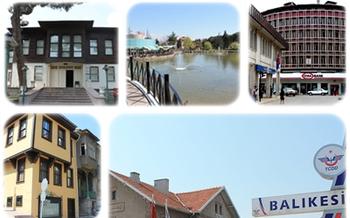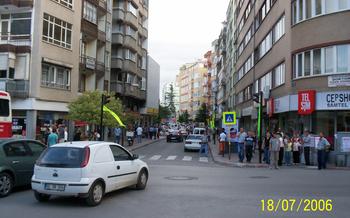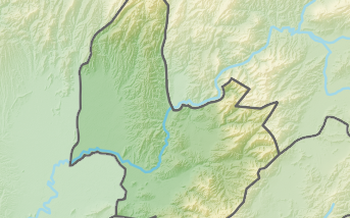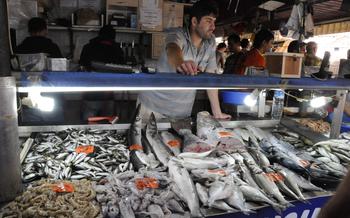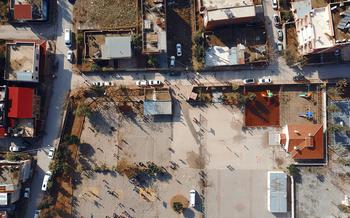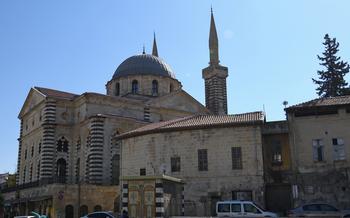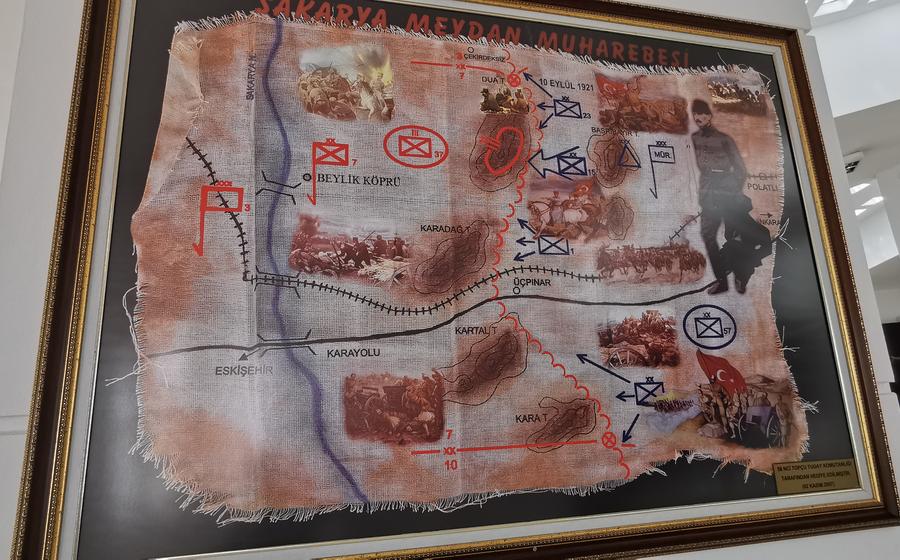
Ali Fuat Paşa Mosque
- The Ali Fuat Paşa Mosque: A Historical and Architectural Gem
- Location and Accessibility:
- History and Background
- Architectural Features
- Religious Significance
- Visiting the Mosque: Etiquette and Guidelines
- Guided Tours and Brochures
- Exploring the Surrounding Area
- Prayer Facilities
- Events and Activities
- Restoration and Preservation
- Local Stories and Legends
- Photography Tips: Capturing the Essence of Ali Fuat Paşa Mosque
- Insider Tip: Unveiling a Culinary Delight
The Ali Fuat Paşa Mosque: A Historical and Architectural Gem
Nest Mosque stands as a testament to the city's rich history and architectural prowess. Built in the early 20th century, this imposing edifice is not just a place of worship but also a stunning representation of Islamic architecture, blending traditional Ottoman elements with modern influences. Its construction was commissioned by Ali Fuat Paşa, a renowned Turkish general and statesman, who sought to create a lasting legacy for his beloved city. The mosque has since become an iconic landmark, attracting countless visitors who come to marvel at its beauty and immerse themselves in its spiritual atmosphere.
Unique Architectural Features:
The Ali Fuat Paşa Mosque boasts several distinctive architectural features that set it apart from other mosques in the region. Its exterior facade is adorned with intricate carvings and tiles, showcasing the exquisite craftsmanship of its builders. The minarets, towering over the city skyline, are adorned with intricate designs that reflect the fusion of Ottoman and Seljuk architectural styles. The interior of the mosque is equally impressive, featuring a spacious prayer hall with elegant arches, stained glass windows, and a majestic dome. The intricate calligraphy adorning the walls and ceilings adds to the spiritual ambiance of the space, creating a sense of awe and reverence for visitors.
Importance as a Cultural Landmark:
The Ali Fuat Paşa Mosque holds significant cultural and historical importance for the people of Sakarya. It stands as a symbol of the city's rich heritage, showcasing the fusion of Islamic architecture with modern influences. The mosque has played a pivotal role in fostering a sense of community and spiritual connection among the residents of Sakarya, serving as a place of worship, gathering, and celebration. Its enduring legacy as a cultural landmark ensures that the mosque will continue to be a source of pride and inspiration for generations to come.
Location and Accessibility:
The Ali Fuat Paşa Mosque stands majestically in the heart of Sakarya, Turkey, at Atatürk Bulvarı No:161, Sakarya Merkez/Sakarya. Reaching this architectural marvel is a breeze, whether you choose to navigate the city's efficient public transportation system or embark on a scenic self-drive journey.
For those relying on public transport, the Ali Fuat Paşa Mosque is conveniently located within walking distance from the Sakarya Train Station and several bus stops. The mosque's proximity to the city center makes it easily accessible by foot or bicycle, allowing you to soak in the vibrant atmosphere of this bustling Turkish city.
If you prefer the freedom of driving, the mosque offers ample parking facilities, ensuring a hassle-free visit. Once you arrive, you'll find yourself surrounded by an array of attractions, including museums, parks, and traditional Turkish bazaars, inviting you to explore the rich tapestry of Sakarya's cultural heritage.
History and Background
The construction of the Ali Fuat Paşa Mosque was initiated in 1889, during the reign of Sultan Abdul Hamid II, by a devoted Muslim philanthropist named Ali Fuat Paşa. Ali Fuat Paşa was a distinguished military commander and statesman who held a deep reverence for Islam and its traditions. Driven by his religious convictions and a desire to leave a lasting legacy, he commissioned the construction of this magnificent mosque as a testament to his faith.
The task of designing and overseeing the construction of the mosque was entrusted to a renowned architect named Vedat Tek. Vedat Tek was a master of his craft, known for his innovative approach and meticulous attention to detail. Inspired by traditional Islamic architecture, he envisioned a mosque that would not only serve as a place of worship but also stand as a symbol of cultural pride and architectural excellence.
The construction of the Ali Fuat Paşa Mosque spanned several years, with artisans and craftsmen from across the region contributing their skills and expertise. The mosque's intricate carvings, elegant calligraphy, and stunning tilework reflect the dedication and artistry of these talented individuals. Upon its completion in 1895, the Ali Fuat Paşa Mosque emerged as a testament to the enduring spirit of Islamic faith and the architectural prowess of the Ottoman Empire.
Architectural Features
The Ali Fuat Paşa Mosque stands out for its exquisite architectural design, blending traditional Islamic elements with modern influences. Its exterior facade captivates visitors with intricate tilework, delicate carvings, and graceful arches. The minarets, reaching towards the sky, are adorned with intricate balconies and topped with elegant domes, symbolizing the mosque's spiritual significance.
Stepping inside the mosque, visitors are greeted by a spacious and awe-inspiring interior. The central prayer hall is supported by rows of slender columns, creating a sense of grandeur and openness. The mihrab, indicating the direction of Mecca, is elaborately decorated with colorful tiles and intricate calligraphy, serving as the focal point of the mosque's interior.
The mosque's interior is further embellished with stunning chandeliers, hanging gracefully from the ceiling and illuminating the space with a warm glow. The walls are adorned with verses from the Quran, beautifully inscribed in calligraphy, adding to the mosque's spiritual ambiance.
Overall, the architectural features of the Ali Fuat Paşa Mosque showcase a harmonious blend of traditional Islamic design principles and modern aesthetics, creating a space that is both aesthetically pleasing and spiritually uplifting.
Religious Significance
The Ali Fuat Paşa Mosque holds immense religious significance for the Muslim community in Sakarya. As a place of worship, it serves as a spiritual center where Muslims gather for daily prayers, Friday congregational prayers (Jummah), and special religious occasions. The mosque's imposing presence and intricate architecture symbolize the deep-rooted Islamic faith and traditions in the region.
The mosque is not only a place for prayer but also serves as a venue for various religious ceremonies and practices. During the holy month of Ramadan, the mosque hosts special Taraweeh prayers, Quran recitations, and Iftar gatherings. It also plays a vital role in celebrating religious festivals such as Eid al-Fitr and Eid al-Adha, where Muslims gather to offer prayers, exchange greetings, and share in the festive spirit.
Beyond its religious functions, the Ali Fuat Paşa Mosque serves as a symbol of unity and community for Muslims in Sakarya. It fosters a sense of belonging and togetherness, providing a space for social and cultural interactions. The mosque's religious significance extends beyond its walls, as it represents the rich Islamic heritage and spiritual traditions that are an integral part of the city's cultural identity.
Visiting the Mosque: Etiquette and Guidelines
When visiting the Ali Fuat Paşa Mosque, it is important to observe proper etiquette and customs to ensure a respectful and meaningful experience. Dress modestly and appropriately, covering your shoulders and knees. Women may also choose to cover their hair as a sign of respect. Upon entering the mosque, remove your shoes and place them neatly in the designated shoe racks. Maintain a respectful demeanor and avoid loud conversations or disruptive behavior. Photography is generally allowed within the mosque, but it is essential to be mindful of the privacy of other visitors and avoid taking intrusive or disrespectful shots. The most serene time to visit the mosque is during the early morning or late afternoon, when the crowds are smaller, and the atmosphere is more tranquil.
Guided Tours and Brochures
Guided tours of the Ali Fuat Paşa Mosque are available for those who want to immerse themselves in its history and architecture. These tours are conducted by knowledgeable guides who provide insights into the mosque's construction, design, and religious significance. Guided tours can be arranged through the mosque's administration office or local tour operators.
Brochure materials and maps are available at the mosque's entrance for visitors who prefer self-guided exploration. These brochures provide a wealth of information about the mosque's history, architectural features, and religious significance. They also include a map of the mosque, highlighting important areas and points of interest.
For a more personalized experience, visitors can opt for a private tour led by a local guide. Private tours offer a flexible schedule and allow for in-depth exploration and discussions. Visitors can request specific areas or aspects of the mosque they would like to focus on, ensuring a tailored and enriching experience.
Exploring the Surrounding Area
Beyond the spiritual and historical significance of the Ali Fuat Paşa Mosque, visitors can immerse themselves in the vibrant cultural tapestry of Sakarya by exploring the surrounding area. A short stroll from the mosque leads to the bustling Sakarya Bazaar, where one can haggle for traditional Turkish handicrafts, carpets, jewelry, and souvenirs. Indulge in the flavors of Turkish cuisine at nearby restaurants, savoring mouthwatering kebabs, gözleme, and baklava.
For those interested in history, the Sakarya Museum, located just a few minutes away, offers a glimpse into the region's rich past. Here, visitors can explore exhibits showcasing archaeological artifacts, historical documents, and cultural relics that tell the story of Sakarya from ancient times to the present day.
Nature enthusiasts can seek respite in the serene environs of Sakarya Park, a verdant oasis just a short drive from the mosque. With its tranquil walking trails, picturesque picnic spots, and a small lake, the park provides a welcome escape from the hustle and bustle of city life.
Prayer Facilities
The Ali Fuat Paşa Mosque offers dedicated prayer areas for both men and women, ensuring a comfortable and serene environment for worship. These areas are designed to accommodate a large number of worshippers, facilitating daily prayers and special religious occasions. Ablution facilities, including wudu areas, are conveniently located within the mosque, allowing visitors to perform the necessary purification rituals before prayer. Prayer mats are readily available for those who need them, and guidance is provided for those who are new to Islamic prayer practices. The mosque's tranquil atmosphere and ample prayer spaces create an ideal setting for contemplation, reflection, and spiritual connection.
Events and Activities
The Ali Fuat Paşa Mosque is not just a place for prayer and religious ceremonies; it also serves as a venue for various events and activities that promote cultural exchange and community engagement. Throughout the year, the mosque organizes educational workshops, seminars, and lectures on Islamic history, art, and architecture. These events provide a platform for scholars, experts, and community members to share knowledge and foster interfaith dialogue.
In addition, the mosque hosts religious festivals and celebrations that attract both local and international visitors. During the holy month of Ramadan, the mosque comes alive with special prayers, Taraweeh, and Iftar gatherings. The mosque also organizes Eid al-Fitr and Eid al-Adha celebrations, which feature communal prayers, feasts, and cultural performances. These events are a wonderful opportunity to witness the vibrant Muslim traditions and customs firsthand.
Restoration and Preservation
The Ali Fuat Paşa Mosque has undergone several restoration and preservation projects to maintain its historical integrity and architectural beauty. In the early 20th century, the mosque underwent extensive renovations to repair damages caused by natural disasters and the passage of time. These renovations focused on preserving the original design and materials used in its construction.
In recent years, the mosque has been the subject of a comprehensive restoration project aimed at addressing structural issues, restoring its intricate decorations, and improving its overall functionality. This project involved the restoration of the mosque's exterior facade, the repair of its interior walls and ceilings, and the cleaning and restoration of its stained glass windows.
The restoration process required meticulous attention to detail and adherence to traditional techniques to ensure that the mosque's original character was preserved. Craftsmen and artisans skilled in traditional Islamic architecture worked alongside modern conservators to restore the mosque's intricate tilework, calligraphy, and decorative elements.
The successful completion of these restoration efforts has ensured that the Ali Fuat Paşa Mosque continues to stand as a testament to Turkish architectural heritage and Islamic art. It serves as a reminder of the importance of preserving cultural landmarks and ensuring their legacy for future generations.
Local Stories and Legends
The Ali Fuat Paşa Mosque has become a backdrop for numerous local stories and legends that have been passed down through generations. One popular tale tells the story of a young woman named Ayşe, who sought refuge in the mosque during a thunderstorm. As she prayed for protection, a bright light shone from the mihrab, and she was filled with a sense of peace and tranquility. From that day on, Ayşe became a devoted follower of Islam and a regular visitor to the mosque.
Another story tells of a group of travelers who lost their way in the forest near the mosque. They wandered for days, lost and hungry, until they stumbled upon the mosque's courtyard. The imam welcomed them with open arms, offering them food, water, and shelter. Touched by his kindness, the travelers converted to Islam and stayed in the village, becoming part of the community.
Photography Tips: Capturing the Essence of Ali Fuat Paşa Mosque
The Ali Fuat Paşa Mosque offers a wealth of photographic opportunities for capturing its architectural grandeur and spiritual essence. To make the most of your visit, consider these tips:
-
Golden Hour Magic: Plan your visit during the golden hours of sunrise or sunset when the warm light bathes the mosque's exterior in a magical glow, enhancing its visual appeal.
-
Lenses for Every Angle: Bring a wide-angle lens to capture the mosque's imposing facade and a telephoto lens to zoom in on intricate details and decorative elements.
-
Creative Perspectives: Experiment with different angles and perspectives to create unique shots. Try capturing the mosque's reflection in a nearby water body or shooting from an elevated vantage point to showcase its grandeur.
-
Respectful Photography: Remember that this is a place of worship, so be respectful of worshippers and avoid disrupting ongoing religious activities. Use a silent camera mode and be mindful of your surroundings.
Insider Tip: Unveiling a Culinary Delight
During my visit to the Ali Fuat Paşa Mosque, I stumbled upon a culinary gem that I couldn't resist sharing. Just a few steps away from the mosque, nestled amidst the vibrant streets, lies a charming little eatery named "Köfteci Mehmet." This unassuming gem serves up some of the most delectable köfte (Turkish meatballs) I've ever tasted. The succulent meatballs, grilled to perfection, are a feast for both the eyes and the taste buds. Pair them with a refreshing glass of ayran (a traditional yogurt drink), and you'll have the perfect post-mosque visit meal. Don't miss out on this hidden culinary treasure when exploring the Ali Fuat Paşa Mosque.
